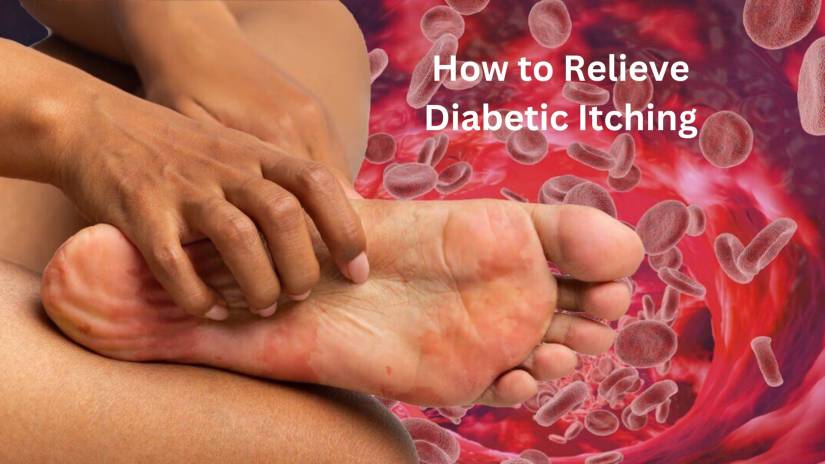How to Relieve Diabetic Itching
Managing diabetes comes with lots of challenges, and among them, diabetic itching can be particularly frustrating. This condition, often resulting from poor blood sugar control, can lead to persistent and uncomfortable itching. Fortunately, there are several strategies to alleviate this symptom and improve your quality of life.
Introduction
Diabetic itching is a common and often frustrating symptom for people with diabetes, which can significantly impact their quality of life. It’s important to understand its causes, symptoms, and treatments. This comprehensive guide gives you the knowledge you need to manage and how to relieve diabetic itching effectively, from simple home remedies to advanced medical treatments.
What is Diabetic Itching?
Diabetic itching or pruritus is a common symptom in people with diabetes. It is often caused by poor blood circulation, dry skin, and nerve damage due to chronically high blood sugar levels. Itching can range from mild to severe and affects various body parts, including the lower legs, feet, arms, and back.
Causes of Diabetic Itching
High Blood Sugar Levels
One of the leading causes of itching due to diabetes is high blood sugar levels. High glucose levels can cause the skin to dry, leading to itching. Additionally, prolonged high blood sugar can damage blood vessels and nerves, making the problem even more severe.
Poor Circulation
Diabetes can lead to poor blood circulation, especially in the extremities, such as the legs and feet. Reduced blood flow can cause the skin to become dry and itchy.
Diabetic Neuropathy
Nerve damage, or neuropathy, is a common complication of diabetes. It can cause various symptoms, including itching. Neuropathy often affects the legs and feet but can occur anywhere on the body.
Skin Infections
Due to a weakened immune system, people with diabetes are more prone to skin infections. Fungal and bacterial infections can cause itching and other discomforts.
Allergic Reactions
People with diabetes may experience allergic reactions to certain medications, foods, or skincare products, which can cause itching.
Symptoms of Diabetic Itching
- Localized Itching: Diabetic itching can occur in specific body areas, such as the lower legs, feet, and arms. It may also affect the scalp and back.
- Dry and Flaky Skin: Along with itching, people with diabetes often experience dry and flaky skin, particularly on the legs and feet.
- Redness and Inflammation: The affected areas may become red and inflamed, mainly if scratching has caused skin damage.
- Blisters and Sores: In severe cases, persistent scratching can lead to blisters, sores, and even infections.
Diagnosis of Diabetic Itching
- Medical History and Physical Examination: A healthcare provider will take a detailed medical history and perform a physical examination to determine the cause of the itching.
- Blood Tests: Blood tests can help monitor blood sugar levels and identify underlying conditions contributing to itching.
- Skin Biopsy: A skin biopsy may be necessary to rule out other skin conditions or infections.
Home Remedies for Diabetic Itching
- Moisturizing Regularly: Keeping the skin moisturized is crucial in managing diabetic itching. To prevent dryness, use a gentle, fragrance-free moisturizer several times daily.
- Using Oatmeal Baths: Oatmeal baths can soothe itching and provide relief. Add colloidal oatmeal to your bathwater and soak for 15-20 minutes.
- Applying Aloe Vera Gel: Aloe vera has natural soothing properties that alleviate itching. To relieve itching, apply pure aloe vera gel to the affected areas.
- Avoiding Hot Showers: Hot water can strip the skin of natural oils, exacerbating dryness and itching. Opt for lukewarm showers instead.
- Using Humidifiers: Humidifiers can add moisture to the air, preventing skin from drying out, especially during colder months.
- Wearing Soft, Breathable Fabrics: Clothing from soft, breathable fabrics like cotton can reduce irritation and itching.
Medical Treatments for Diabetic Itching
- Topical Corticosteroids: A healthcare provider may prescribe topical corticosteroids to reduce inflammation and itching for severe itching.
- Antihistamines: Oral antihistamines can help manage itching caused by allergic reactions or other underlying conditions.
- Antifungal and Antibiotic Treatments: If the itching is due to a fungal or bacterial infection, appropriate antifungal or antibiotic treatments may be necessary.
- Blood Sugar Management: Managing blood sugar levels through diet, exercise, and medication is crucial in preventing and alleviating diabetic itching.
Diet and Lifestyle Changes
- Maintaining Hydration: Drinking plenty of water can keep the skin hydrated and reduce dryness and itching.
- Healthy Diet: A balanced diet rich in vitamins and minerals supports overall skin health. To promote skin healing, include foods high in antioxidants, such as fruits and vegetables.
- Regular Exercise: Exercise improves blood circulation, which can help alleviate itching. Aim for at least 30 minutes of moderate exercise most days of the week.
Preventive Measures for Diabetic Itching
- Regular Skin Inspections: Inspect your skin regularly for any dryness, redness, or infection. Early detection and treatment can prevent itching from worsening.
- Foot Care: Proper foot care is essential for people with diabetes. Keep your feet moisturized, and check for cuts, blisters, or sores.
- Managing Blood Sugar Levels: Keeping blood sugar levels within the target range is the most effective way to prevent diabetic complications, including itching.
- Using Gentle Skin Care Products: Choose skincare products free of harsh chemicals, fragrances, and dyes. Opt for hypoallergenic and gentle formulas to reduce irritation.
Psychological Impact of Diabetic Itching
- Anxiety and Stress: Chronic itching can lead to anxiety and stress, affecting mental health. Finding effective coping mechanisms and seeking support is essential.
- Sleep Disturbances: Itching can interfere with sleep, leading to fatigue and reduced quality of life. Establishing a bedtime routine and using antihistamines may help.
- Quality of Life: Persistent itching can significantly impact daily activities and overall quality of life. Finding effective treatments and support is crucial for well-being.
Natural Remedies for Diabetic Itching
- Coconut Oil: Coconut oil has moisturizing and antimicrobial properties that can soothe itching and prevent infections. Apply it to the affected areas regularly.
- Tea Tree Oil: Tea tree oil has antifungal and antibacterial properties that can help manage itching caused by infections. Dilute it with a carrier oil before applying it to the skin.
- Apple Cider Vinegar: Apple cider vinegar can balance the skin’s pH and alleviate itching. Dilute it with water and apply it to the affected areas using a cotton ball.
- Baking Soda Paste: A baking soda and water paste can relieve itching. Apply the paste to the affected areas and leave it on for 15-20 minutes before rinsing off.
When to See a Doctor?
- Persistent Itching: If itching persists despite home remedies and over-the-counter treatments, seeking medical advice for further evaluation is essential. This reassures you that you’re not alone in managing your condition.
- Signs of Infection: Seek medical attention if you notice signs of infection, such as redness, swelling, warmth, or pus.
- Uncontrolled Blood Sugar Levels: If your blood sugar levels are consistently high and causing symptoms like itching, work with your healthcare provider to adjust your diabetes management plan.
FAQs
What causes diabetic itching?
High blood sugar levels, poor circulation, and nerve damage often cause diabetic itching. Dry skin and infections can also trigger it.
How can I relieve diabetic itching at home?
Home remedies such as moisturizing regularly, using oatmeal baths, applying aloe vera gel, avoiding hot showers, using humidifiers, and wearing soft, breathable fabrics can help relieve diabetic itching.
What are the best treatments for diabetic itching?
Treatments for diabetic itching include:
- Topical corticosteroids.
- Antihistamines.
- Antifungal and antibiotic therapies.
- Managing blood sugar levels through diet, exercise, and medication.
Can diet and lifestyle changes help with diabetic itching?
Maintaining hydration, following a healthy diet, and exercising regularly can improve skin health and reduce itching.
How can I prevent diabetic itching?
Preventive measures include:
- Regular skin inspections.
- Proper foot care.
- Managing blood sugar levels.
- Using gentle skin care products.
When should I see a doctor for diabetic itching?
Consult a healthcare provider if itching persists despite home remedies, if there are signs of infection, or if blood sugar levels are uncontrolled and causing symptoms.
Conclusion
Relieving diabetic itching requires a multifaceted approach, including managing blood sugar levels, using effective home remedies, and seeking medical treatment when necessary. By understanding the causes, symptoms, and treatments of diabetic itching, individuals can improve their quality of life and reduce discomfort. Regular skin care, proper foot care, and lifestyle changes are crucial in preventing and managing this common diabetes symptom.










